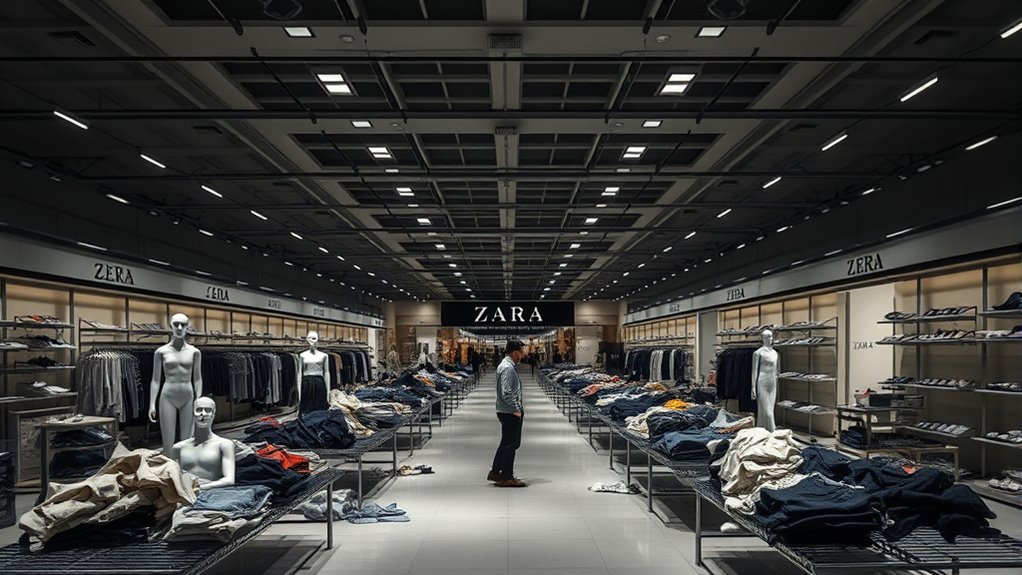Zara’s retrenchment signals a shift in fast fashion as industry challenges grow. You’ll see how environmental concerns, ethical issues, and market saturation threaten its quick turnaround model. Consumers now prefer sustainable, durable pieces, prompting Zara and others to rethink their strategies. Rising costs and economic pressures add to the slowdown. If you want to understand how these trends reshape the future of fashion, there’s more to explore.
Key Takeaways
- Zara’s rapid expansion faces saturation, economic pressures, and rising costs, prompting a strategic retreat to focus on sustainability.
- Industry shift toward eco-friendly practices and ethical labor standards challenges Zara’s fast fashion model.
- Consumer demand for sustainable, durable products leads Zara to prioritize quality over quick turnover.
- Supply chain disruptions and environmental concerns force Zara to slow growth and adopt responsible manufacturing.
- Retrenchment aims to enhance brand resilience by aligning with market trends toward transparency and sustainability.
The Rise and Dominance of Zara in Fast Fashion

Zara’s rapid rise to dominance in the fast fashion industry can be attributed to its innovative approach to supply chain management and quick turnaround times. By implementing supply chain innovations, Zara streamlines every stage from design to delivery, allowing it to respond swiftly to changing trends. This agility enables Zara to produce new styles in just a few weeks, keeping stores fresh and consumers engaged. Additionally, Zara’s focus on brand diversification helps it appeal to a broad customer base, offering everything from casual wear to more sophisticated pieces. This strategic variety ensures Zara remains competitive and relevant across different markets. Together, these tactics establish Zara as a leader in fast fashion, setting a standard that competitors aim to emulate. The integration of design thinking principles further enhances Zara’s ability to innovate and adapt efficiently. Moreover, Zara’s emphasis on supply chain management and rapid inventory turnover allows it to minimize excess stock and respond to market demands in real-time. An emphasis on consumer preferences and data-driven decision making is central to maintaining its market position and staying ahead of trends.
Environmental and Ethical Challenges Facing the Industry

As the fast fashion industry grows, its environmental and ethical challenges become increasingly urgent. You face the impact of rapid production that often neglects sustainable manufacturing practices, leading to pollution and waste. Ethical labor is also a concern, as workers may endure poor conditions for low wages. To understand these issues better, consider this table:
| Challenge | Impact |
|---|---|
| Unsustainable manufacturing | Environmental degradation, waste accumulation |
| Exploitative labor practices | Worker exploitation, social inequality |
| Fast turnover demands | Overproduction, increased waste |
Addressing these challenges requires a shift towards ethical labor standards and sustainable manufacturing, which are essential to ensuring industry growth doesn’t come at the planet’s expense. Promoting sustainable manufacturing practices can significantly reduce environmental harm and promote fair labor conditions across the sector. Moreover, developing a comprehensive understanding of ethical labor standards can help drive meaningful change in industry practices. Implementing responsible production methods is crucial for long-term sustainability and corporate accountability.
Consumer Shifts Toward Sustainability and Ethical Shopping

Growing awareness of the environmental and ethical issues in fast fashion has led consumers to rethink their shopping habits. You’re now more likely to seek out sustainable alternatives that prioritize eco-friendly materials and fair labor practices. Ethical consumerism guides many to support brands committed to transparency and responsible production. Instead of buying cheap, disposable clothing, you prefer quality pieces that last longer and align with your values. This shift reflects a desire to reduce waste and minimize environmental impact, challenging traditional fast fashion giants. Additionally, increased color accuracy in fashion product branding helps consumers better assess the true quality and sustainability of clothing items online. As a result, you’re increasingly drawn to brands that demonstrate genuine sustainability efforts. Your choices aim to make a positive difference, encouraging companies to adopt more ethical practices and move away from the rapid turnover model that previously dominated the industry.
Market Saturation and Economic Pressures Impacting Zara

Despite its rapid expansion, Zara faces increasing challenges from market saturation and mounting economic pressures. As more brands flood the fast fashion space, Zara struggles to find new markets and maintain growth, leading to a saturated retail environment. Consumers are becoming more selective, limiting overall demand for fast fashion, especially in mature markets. Simultaneously, economic pressures like inflation, rising labor costs, and supply chain disruptions squeeze profit margins. These factors force Zara to reconsider its aggressive store expansion and inventory strategies. With limited room for growth and higher operational costs, Zara’s ability to sustain its previous momentum diminishes. Market saturation and economic pressures therefore play a critical role in slowing Zara’s growth and forcing the company to adapt or face decline.
Future Outlook: What Zara’s Retrenchment Means for Fast Fashion

What does Zara’s retreat from aggressive expansion mean for the future of fast fashion? It signals a shift toward sustainable innovation, emphasizing quality and longevity over rapid turnover. This change challenges the industry to prioritize environmentally friendly practices and transparent supply chains, fostering consumer trust. Zara’s focus on retrenchment demonstrates that brand resilience depends on adapting to market demands for sustainability. As fast fashion brands rethink growth strategies, you can expect a move toward more responsible production models that balance profitability with ecological impact. This evolution may slow growth but strengthens brand reputation, ensuring long-term relevance. Incorporating green chemistry principles into manufacturing processes could further support these sustainable shifts. Additionally, understanding hours today list helps brands optimize store operations during transitional periods. Recognizing relationship dynamics within consumer behavior can further influence how brands adapt to these industry shifts. Embracing sustainable material sourcing can also enhance brand credibility and appeal to eco-conscious consumers. Ultimately, Zara’s retrenchment could set a new standard, encouraging other brands to innovate responsibly and build resilient, sustainable business models in a competitive market.
Frequently Asked Questions
How Does Zara Plan to Reinvent Its Brand Strategy Post-Retrenchment?
You should focus on Zara’s brand repositioning by embracing digital transformation to reconnect with customers. They plan to enhance online shopping, leverage data for personalized experiences, and streamline supply chains for faster delivery. This strategic shift aims to boost brand relevance and sustainability, making Zara more agile and customer-centric. By prioritizing digital innovation, Zara can reinvent itself, attract new audiences, and regain its competitive edge in the fast fashion industry.
What Specific Ethical Issues Prompted Zara’S Recent Retrenchment?
Imagine a once-glittering mirror shattering, revealing cracks beneath. That’s what you see when you learn about Zara’s recent retrenchment. It was driven by ethical issues like labor violations and environmental violations, which tarnished its reputation. These issues highlight the darker side of fast fashion, forcing Zara to confront its impact on workers and the planet, pushing it to rethink and reshape its brand values for a more sustainable future.
Will Zara Introduce New Sustainable Clothing Lines to Regain Market Share?
You can expect Zara to introduce new sustainable clothing lines soon, focusing on sustainable innovation to appeal to eco-conscious consumers. This move aims to boost market differentiation, helping Zara regain lost market share. By emphasizing eco-friendly materials and ethical production practices, Zara shows its commitment to sustainability, giving you more responsible fashion options and aligning with the growing demand for environmentally conscious brands.
How Has Consumer Backlash Influenced Zara’S Operational Restructuring?
Think of consumer backlash as a wake-up call that hit Zara hard. It’s prompted you to see how their supply chain issues and lack of transparency shake consumer trust. This trust is the bedrock of their success, and now, Zara’s restructuring aims to rebuild it by overhauling supply chain practices and prioritizing sustainability. Your confidence in their brand depends on how well they respond to these challenges and regain your trust.
What Lessons Can Other Fast Fashion Brands Learn From Zara’S Decline?
You should learn that adapting your supply chain and market strategies is essential for survival. Zara’s decline shows that rapid market changes demand flexible supply chains and swift market adaptation. If you ignore consumer backlash and shifting preferences, you risk falling behind. Stay responsive, innovate continuously, and prioritize sustainable practices to maintain relevance. This proactive approach helps you navigate challenges and sustain growth in the competitive fast fashion industry.
Conclusion
Remember, every cloud has a silver lining. Zara’s retrenchment shows that even giants must adapt to shifting consumer values and rising sustainability demands. By embracing ethical practices and innovation, you can stay ahead in the evolving fast fashion landscape. Don’t forget, it’s not how many times you fall, but how you rise that counts. Keep your eyes open and stay flexible—your success depends on it.









